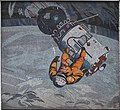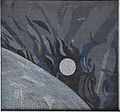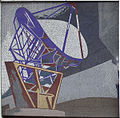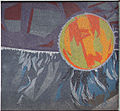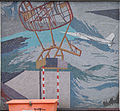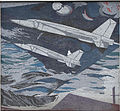Fritz Eisel
Fritz Eisel (born March 27, 1929 in Lauterbach (Hesse) , † September 19, 2010 in Langen Brütz ) was a German painter .
Life
Eisel completed his studies at the University of Architecture and Fine Arts Weimar from 1947 to 1950 . His teachers there included Hans Hofmann-Lederer and Fritz Dähn . Dähn went to the Dresden Academy of Fine Arts in 1950 , where Eisel followed him. In 1951 he went to the Repin Institute Leningrad of the Academy of Arts of the USSR where he worked with Boris Joganson .
From 1957 to 1959 he lived in Dresden, where he worked as a freelance artist and in 1958 received the Art Prize of the German-Soviet Friendship . In 1959 he moved to Potsdam, where he was to stay until 1970.
In 1970 he followed a call to the Dresden University of Fine Arts, where he was appointed professor in 1973. From 1975 to 1979 he was rector of the same university. Since 1982 he has lived in Langen Brütz as a freelance artist.
His marriage to Christa Eisel (née Lörsch) in 1951 resulted in two children, including their son Paul Eisel and the journalist and author Carla Kalkbrenner . Two of his four grandchildren are the musicians Paul and Fritz Kalkbrenner .
Awards
- 1958 Art Prize of the Society for German-Soviet Friendship
- 1961 Theodor Fontane Prize of the Potsdam district
- 1975 Art Prize of the GDR
- 1977 Martin Andersen Nexö Art Prize from the City of Dresden
Exhibitions
Eisel's works can be found in the Neue Meister gallery , Dresden, Neue Nationalgalerie Berlin , Staatliche Museum Moritzburg , Staatliche Kunstsammlungen Weimar , Staatliche Museum Schwerin , National Gallery of Modern Art New Delhi , the Deutsche Bank Luxemburg collection and the North German painting collection of NDR. One of his rare wall designs, the folk dance , is in Frankfurt (Oder) .
Another large wall design is located in Potsdam on Dortustraße at the former data processing center (planned by Sepp Weber from 1969 to 1971). It is an exterior mosaic (clad three sides of the base of the building) with the title “Man conquers the cosmos”. In addition to the depiction of the Soviet cosmonaut Yuri Alexejewitsch Gagarin, there is the following quote from Karl Marx at the very end of the mosaic volume :
- “The less time society needs to produce wheat, cattle, etc., the more time it gains for other production, material or spiritual. Economy of Time - This is where all economy finally dissolves. Economy of time, as well as the planned distribution of working time to the various branches of production, remains the first economic law on the basis of social production. "
A special feature can be discovered on the west side (in Dortustraße) - the mosaics there were incorrectly used during final assembly. Actually, a truncated planet should be visible over three surfaces . During assembly, however, its outer surfaces were swapped and the surface mounted on the left was rotated 180 degrees.
Two mosaics on the facade facing the Breite Straße show MiG fighter planes flying westwards , which “can definitely be understood as a military threatening gesture”.
North side:
West side left:
West side right:
South side left:
South side center:
South side right:
Effect on site:
literature
- Sager, Peter: On the way to artists and pictures - reports and portraits, DuMont Buchverlag Cologne 1988 / p. 192–199
- ZEITmagazin No. 51/10. December Hamburg 1976 pp. 24-38
- Schumann, Henry: Atelier Talks. Leipzig, EA Seemann Verlag, 1976
- "As if bundled light were falling on summery land" Fritz Eisel on his 75th birthday / article in the "Schweriner Volkszeitung" on March 26, 2009
- Literature by and about Fritz Eisel in the catalog of the German National Library (dataset on Fritz Eisel • PICA dataset)
- Short biography for: Eisel, Fritz . In: Who was who in the GDR? 5th edition. Volume 1. Ch. Links, Berlin 2010, ISBN 978-3-86153-561-4 .
Web links
Individual evidence
- ^ A b Paul Kalkbrenner: Junge aus Ostberlin bei zeit.de, accessed on July 25, 2014
- ↑ Margrit Höfer, accordion plays to dance , Märkische Oderzeitung / Frankfurter Stadtbote, Dec. 18, 2006, p. 15
- ↑ PotsdamWiki - Computer Center ( Memento from December 20, 2007 in the Internet Archive )
- ^ Andreas Kitschke: The Garrison Church Potsdam. Crown of the city and the setting for history. Bebra-Verlag, Berlin 2016, ISBN 978-3-86124-694-7 , p. 197.
| personal data | |
|---|---|
| SURNAME | Eisel, Fritz |
| ALTERNATIVE NAMES | Eisel, Friedrich |
| BRIEF DESCRIPTION | German painter |
| DATE OF BIRTH | March 27, 1929 |
| PLACE OF BIRTH | Lauterbach (Hesse) |
| DATE OF DEATH | September 19, 2010 |
| Place of death | Langen Brütz |


